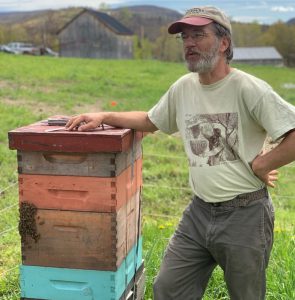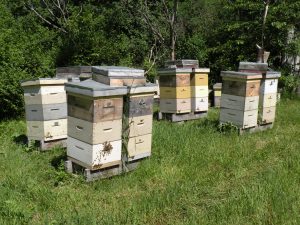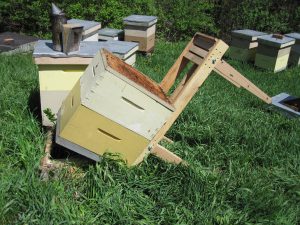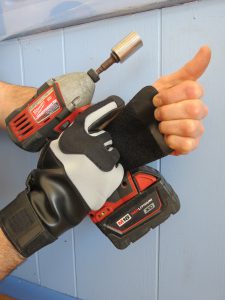Click Here if you listened. We’d love to know what you think. There is even a spot for feedback!
Read along below!

Adaptive Beekeeping
Some possible solutions for “when your mind makes a promise that your body can’t fill.”*
By: Ross Conrad
I turned 60 last year and I’m starting to contemplate how much longer I will be physically able to keep bees on the scale that I have grown used to. This led me to attend an online adaptive beekeeping webinar. The webinar was hosted by the organization AgrAbility whose motto is “Cultivating Assessable Agriculture.” According to their website, the mission of AgrAbility is “to enhance quality of life for farmers, ranchers and other agricultural workers with disabilities, so that they, their families and their communities continue to succeed in rural America.” AgrAbility allows farmers, loggers and fishermen to keep working even when disabled from old age, injury or illness. The online program opened me up to the world of adaptive beekeeping tools and technologies that just might help me continue to keep bees well into my 90’s, should I make it that far.

Rich Weiske, president of the Michigan Beekeepers Association, demonstrates the rotating horizontal hive from www.horizontalbees.com. This hive will accommodate a person using a wheelchair. Photo courtesy of Ned Stoller, Easterseals Michigan AgrAbility.
Leading the webinar was Michigan AgrAbility Assistive Technology Professional, Ned Stoller, who laid out the three strategies beekeepers like myself can use to adapt and succeed despite many of the physical limitations that one might encounter in life. The three strategies are:
- Use something that has already been invented and is available to make the work easier.
- Modify tools or equipment to enable tasks that would otherwise be impossible or unhealthy.
- Create a new tool entirely from scratch (this is the most expensive approach).
Apiary Access
One of my primary tasks as a beekeeper is to be able to gain access to my apiary and bring along all the tools and equipment needed to work with the bees. Situating apiaries that are close by and in locations that are vehicle accessible enables the use of a wide variety of transportation options, from cars and trucks, to ATVs and golf carts. Should I experience mobility issues, allowing a vehicle to carry me to the beeyard reduces the need to walk loaded down lots of tools and equipment. The effort to transport my tools and equipment can be further reduced by storing them in the beeyard rather than having to carry it all back and forth.
A less potentially expensive option is some type of walk behind, wheeled conveyance such as a green house cart that can carry everything I require for a visit to the apiary. Should I find myself with limited strength, a self-propelled unit that doesn’t need to be pushed such as an electric power-wagon could be more desirable. A motorized hydraulic lift cart would not only carry my stuff, but would prevent me from having to bend over when removing or adding supers.
Whether self-propelled or not, such devices can also serve as a walker to lean on while in transit. Even a tool belt can be considered a mobility device since it can free up hands for handling things like a cane or walker.

Kirk Webster positions his hives just far enough apart that his homemade bench will fit between each set of hives allowing him to work four colonies before having to move his bench to another set of hives. Kirk turns 70 years old next year and says that if it wasn’t for this bench/hive lifter, he wouldn’t still be walking today. Photo courtesy of Kirk Webster, Champlain Valley Bees and Queens.
Hand in hand with getting to the beeyard, is setting the apiary up so that it is easy to move around in. This means setting things up with access in mind, and removing trip hazards such as rocks and tall grass. Ned Stoller recommends laying down an old, used pool cover in the apiary to smother the grass under and around the hives. Appropriate spacing between hives needs to also be considered. Should I get to the point where I am unable to stand for long periods of time, positioning stools by each hive provides a convenient place to sit should I need to rest during a colony inspection.
Hive Work
Years ago, I was told by one of my mentors that all one needs to be a successful beekeeper is a strong back and a weak mind. Deep supers full of honey are around 80 pounds, while even a shallow of honey weighs in at about 40 pounds. Paying attention to proper ergonomics when working in the beeyard is important. When lifting, I try to keep my back straight and lift with my legs by bending my knees rather than bending at the waist. I also try to remember to avoid leaning out or rotating at the waist when lifting or putting something heavy down, and instead use my feet to turn or step closer in order to keep my center of gravity as near to my body as possible.
Another important way to help prevent back injury is by simply staying well hydrated. I can tell you from personal experience that I am much more prone to back aches and muscle spasms when I have not been drinking enough water, than when I have kept myself well hydrated.
Should good ergonomics and hydration not be enough to keep my back in shape, it’s time to reduce the load. One way to do that is to use 8-frame equipment rather than the standard 10-frame hives. Alternatively, frames of honey and brood can be removed one frame at a time rather than by moving an entire super at once. I just need to set up empty supers in which to place each frame once it is removed from the hive. Following the inspection, the frames can be returned to the hive, again, one frame at a time. Another approach is to mentor new beekeepers who can do the lifting for me while I share my knowledge and experience with them.

This bench made by Kirk Webster hooks to the bottom board of the hive so it can be tilted back and raised to waist height for inspections, requiring a minimum amount of bending and lifting on the part of the beekeeper. Photo courtesy of Kirk Webster, Champlain Valley Bees and Queens.
Keeping hives on raised hive stands reduces the need to bend over. Unfortunately, raised hive stands can also create issues during a good honey year if honey supers are stacked high. In such cases, using a step stool or small ladder becomes necessary when inspecting and removing honey supers. Alternatively, harvesting honey periodically throughout the season rather than all at once at the end of the season, would prevent potential injury from lifting heavy honey supers over my head.
Even if I could not stand up, maintaining beekeeping activities is not out of the question thanks to the Easy-B-Stand, the wheelchair accessible swivel horizontal hive. The Easy-B-Stand rotates the hive at a 45 degree angle making the colony accessible even when in a seated position.
Some of my apiaries are located in rough terrain that will make wheelchair access difficult even when populated with hives that tilt. Thus, should I find myself in a wheelchair, I would consider housing hives on a trailer, or in a small building or shed, which would make colonies easier to access by wheelchair, and provide a comfortable inside climate for working in at the same time.
Moving Hives
I am not a big guy, and so while I can move nucleus colonies easily by myself, a two-person hive carrier has been my go to for moving full size hives. Other potential options for moving hives include: hand dollies, a forked hand truck, cranes, the EZ lift hive hand truck, hive lifter tongs, the Kaptar hive body lift or various other hive and super lifters on the market, that are often powered hydraulically or by cables and pulleys.

The GripEeze Velcro grip glove will securely hold a tool without the worker squeezing their hand. This can work for hive tools, uncapper tools, carrying pails, etc. Photo courtesy of Ned Stoller, Easterseals Michigan AgrAbility.
Getting a Grip
Should my hands stop working as well as they used to, and strengthening exercises fail to help increase my gripping strength, I have options. A large number of gripping aids are available on the market from the common Frame Grip, to products like Gripeeze, a grip glove that features a Velcro strap that makes it easy to hang onto something, such as a hive tool, for an extended period of time.
For occasional arthritis flare-ups, beekeeping tools can be modified by simply wrapping them in a piece of pipe insulation. This softens the gripping surface and places less strain on the hands. Similarly, adding ¾ to one inch thick wooden cleats to the outside of supers and hive bodies make them easier to grip and lift.
Should I start finding supers difficult to separate, an extra long hive tool that provides additional leverage to help get those boxes apart just might be the answer I’m looking for.
Less physical, yet just as important to beekeeping is eye sight. Not that this is necessary. François Huber, who was blind, famously studied the honey bee with the help of an assistant and wrote about his findings. I already have four eyes, but if they need additional help, there are numerous vision assisting products available today such as head-mounted beekeeper magnifying glasses that feature a battery-powered lamp for extra light.
Keeping track of things is also an important part of beekeeping. Memory assisting notes that detail important information, whether paper or electronic, helps, as long as I can remember where I put my journal, or the password to access it.
Modifying tools and technologies to compensate for physical disabilities is just one way to adapt in order to continue keeping bees. I know of one commercial beekeeper who upon retirement, sold his beekeeping operation and set things up so that he continued to have a sizable apiary in his backyard and the new owners of his business took on the primary role of caring for the bees, but allow him to continue to putter in the beeyard whenever he wanted even as he aged well into his 90’s.
According to the Centers for Disease Control and Prevention, one out of four people in the U.S. have some form of disability. Whether I have a disability or am just aging naturally, this does not necessarily mean that I have to eventually give up keeping bees as long as I plan ahead and set myself up to be adaptable.
Most old beekeepers seldom retire and stop keeping bees, they just adapt by cutting back. A commercial beekeeper with thousands of colonies might cut back to 100. A sideliner with a couple hundred colonies might reduce the number to a few dozen. And a backyard beekeeper with a dozen or so colonies might cut back to a couple hives. Beekeepers tend to only stop keeping bees when it is simply impossible to do it anymore. As this article indicates, there are a lot of ideas and options out there on how to continue beekeeping, even when ones’ ability to keep on keeping on becomes questionable.
*Line borrowed from the song “Old Folks Boogie” by Little Feat
Ross Conrad keeps bees in Middlebury, VT and is author of The Land of Milk and Honey: A history of beekeeping in Vermont. Ross will be teaching a two day beginner beekeeping intensive May 18-19, 2024. For more information or to register contact Ross at dancingbhoney@gmail.com






